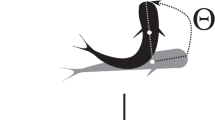Abstract
Shoaling behaviour has been shown to provide many benefits to group members. In this study we examined the ability of fish shoals to escape from a novel trawl apparatus. Fish in shoals of 5 found, and escaped through, a hole in the oncoming trawl more quickly than fish in pairs. Fish in the larger shoals displayed a significant decrease in escape latencies over a series of five trawls, providing clear evidence of net avoidance learning, whereas fish in pairs showed no evidence of learning over successive runs. Observations suggested that more information on the location of the escape route was available to fish in larger shoal sizes owing to social stimulation.
Similar content being viewed by others
References cited
Brown, C. & K. Warburton. 1997. Predator recognition and antipredator responses in the rainbowfish Melanotaenia eachamensis. Behav. Ecol. Sociobiol. 41: 61–68.
Clayton, D.A. 1978. Socially facilitated behaviour. Quart. Review Biol. 53: 373–392.
Elgar, M.A. 1989. Predator vigilance and groups size in mammals and birds: a critical review of the empirical evidence. Biological Reviews 64: 13–33.
Engas, A. 1994. The effects of trawl performance and fish behaviour on the catching efficiency of demersal sampling trawls. pp. 45–65. In: A. Ferno & S. Olsen (ed.) Marine Fish Behaviour in Capture and Abundance Estimation, Fishing News Books, Oxford.
Fitzsimmons, S.D. & K. Warburton. 1992. Fish movement behaviour: variability within and between groups. Behavioural Processes 26: 211–216.
Francis, M.P. & M.W. Williams. 1995. Diel variation in trawl catch rates of Pagrus auratus (Sparidae). Fisheries Research 24: 301–310.
Giraldeau, L.-A., T. Caraco & T.J. Valone. 1994. Social foraging: individual learning and cultural transmission of innovations. Behav. Ecol. 5: 35–43.
Godin, J.G.J., L.J. Classon & M.V. Abrahams. 1988. Group vigilance and shoal size in a small characin fish. Behaviour 104: 29–40.
Godin, J.G.J. & M. Morgan. 1985. Predator avoidance and school size in a cypinidontid fish (Fundulus diaphanus, Lesueur). Behav. Ecol. Sociobiol. 16: 105–110.
Grunbaum, D. 1997. Schooling as a strategy for taxis in a noisy environment. pp. 257–281. In: J.K. Parrish & W.M. Hamner (ed.) Animal Groups in Three Dimensions, Cambridge University Press, Cambridge.
Hale, E.B. 1956. Social facilitation and forebrain function in maze performance of green sunfish, Lepomis cyanellus. Physiological Zoology 25: 93–106.
Hunter, J.R. & W.J. Wisby. 1964. Net avoidance behaviour of carp and other species of fish. J. Fish. Res. Board Can. 21: 613–633.
Krause, J. 1993. Transmission of fright reaction between different species of fish. Behaviour 127: 37–48.
Laland, K.N. & K. Williams. 1997. Shoaling generated social learning of foraging information in guppies. Anim. Behav. 53: 1161–1169.
Lazarus, J. 1979. Flock size and behaviour in captive red-billed weaver birds (Quelea queala): implications for social facilitation and functions of flocking. Anim. Behav. 71: 127–145.
Lima, S.L. 1995. Back to the basics of anti-predatory vigilance: the group-size effect. Anim. Behav. 49: 11–20.
Magurran, A.E. & T.J. Pitcher. 1983. Foraging, timidity and shoal size in minnows and goldfish. Behav. Ecol. Sociobiol. 12: 147–152.
Mathis, A., D.P. Chivers & R.J.F. Smith. 1996. Cultural transmission of predator recognition in fishes; intraspecific and interspecific learning. Anim. Behav. 51: 185–201.
Pitcher, T.J. & A. House. 1987. Foraging rules for group feeders: area copying depends upon density in shoaling goldfish. Ethology 76: 161–167.
Pitcher, T.J., A.E. Magurran & I.J. Winfield. 1982. Fish in larger shoals find food faster. Behav. Ecol. Sociobiol. 10: 149–151.
Pyanov, A.I. 1993. Fish learning in response to trawl fishing. ICES Mar. Sci. Symp. 196: 12–16.
Ryer, C.H. & B.L. Olla. 1992. Social mechanisms facilitating exploitation of spatially variable ephemeral food patches in pelagic marine fish. Anim. Behav. 44: 69–74.
Smith, M.F.L. & K. Warburton. 1992. Predator shoaling moderates the confusion effect in blue-green chromis, Chromis viridis. Behav. Ecol. Sociobiol. 30: 103–107.
Suboski, M.D., S. Bain, A.E. Carty, L.M. McQuoid, M.I. Seelen & M. Seifert. 1990. Alarm reaction in acquisition and social transmission of simulated predator recognition by zebra danio fish (Brachydanio rerio). J. Comp. Psychol. 104: 101–112.
Treherne, J. & W. Foster. 1981. Group transmission of predator avoidance in a marine insect. Anim. Behav. 28: 1119–1122.
Welty, J.C. 1934. Experiments in group behaviour of fishes. Physiological Zoology 7: 85–182.
Author information
Authors and Affiliations
Rights and permissions
About this article
Cite this article
Brown, C., Warburton, K. Social Mechanisms Enhance Escape Responses in Shoals of Rainbowfish, Melanotaenia duboulayi . Environmental Biology of Fishes 56, 455–459 (1999). https://doi.org/10.1023/A:1007518710790
Issue Date:
DOI: https://doi.org/10.1023/A:1007518710790




